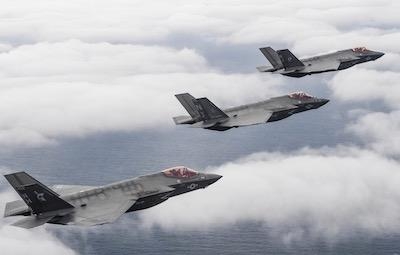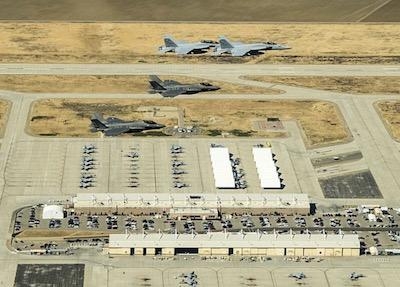Had Been Training F-35C Pilots And Support Personnel For Seven Years
The last F-35C belonging to Strike Fighter Squadron (VFA) 101 “Grim Reapers” left its home base at Eglin, AFB in FL for Naval Air Station Lemoore (NASL) as the squadron deactivated after more than seven years of training F-35C pilots and Sailors and Marines.

Grim Reaper origins can be traced back to 1942. Homeported at NAS San Diego, the squadron was originally known as VF-10 and was flying the F4F Wildcat off USS Enterprise (CV 6) in the Pacific during WWII. After the Battle of Guadalcanal, they returned to the United States and transitioned to the F6F-Hellcat, redeploying to the Pacific aboard Enterprise before eventually transitioning to the F4U Corsair and re-engaging in Pacific air strikes during WWII. In 1945, VF-10 deactivated at NAS Alameda.
In 1952, VF-101 was commissioned at NAS Cecil Field, FL, assuming the nickname and traditions of the previous VF-10 “Grim Reapers,” thus continuing that legacy, flying FG1-D Corsairs in the Korean War. Since then, the Grim Reaper insignia has graced the tail flash of the F2H Banshee, the F4D Skyray, the F3H Demon, the F-4 Phantom II and the F-14 Tomcat. VF-101 was deactivated September 2005.
VFA-101 reactivated in May 2012, on the 60th Anniversary of the Grim Reapers, as the first Lightning II Fleet Replacement Squadron (FRS) for the F-35C. Since then, the squadron has trained more than 75 Navy and Marine Corps F-35C pilots, accepted more than 30 aircraft, trained more than 1,200 F-35C maintainers and flown nearly 11,000 flight hours.
“The contributions that VFA-101 has made to the F-35C community will not diminish as this program grows,” said VFA-101 Commanding Officer Cmdr. Adan Covarrubias. “The original cadre of maintainers and pilots have left a legacy that is evidenced in all aspects of this community. Their influence will continue long after the squadron’s doors are closed.”
Almost 200 people attended Thursday's ceremony as the last Grim Reaper F-35C began its journey to Naval Air Station Lemoore. Attendees included past and present Grim Reaper pilots, crew and family members. Most notably, family members of the original VF-10 Grim Reapers, the Capt. William R. Kane family and the James H. Flatley family, of which there were three generations of Grim Reaper pilots, were in attendance.

The majority of F-35C pilots at VFA-101 will remain in the F-35C community, transferring to VFA-125, VFA-147, VX-9 and Commander, Joint Strike Fighter Wing. Roughly, more than 50 percent of Sailor maintainers from the Grim Reapers will also remain in the F-35C community either at Naval Air Station Lemoore with VFA-125 or VFA-147 or at VX-9 at Edwards Air Force Base.
The deactivation of VFA-101 will not change or alter, in any way, the U.S. Navy Enlisted Maintenance training that is conducted at the Academic Training Center (ATC) at Eglin AFB and the Navy’s support of Test & Evaluation joint development with the U.S. Air Force, U.S. Marine Corps and the partners at Eglin Air Force Base.
Naval Air Station Lemoore (NASL) is the home-base for Commander, Joint Strike Fighter Wing, the Navy’s F-35C fleet squadrons and the Fleet Replacement Squadron (FRS), VFA-125 that trains Navy and Marine Corps CVN-based JSF pilots. To accommodate the F-35C program at NAS Lemoore, several facilities were built or remodeled to facilitate specific F-35C requirements with regard to maintenance and training, including a Pilot Fit Facility, Centralized Engine Repair Facility, Pilot Training Center, and a newly-remodeled Hangar. Future projects are planned as additional Navy squadrons transition into the F-35C. Marine Corps F-35C squadrons will be based at Marine Corps Air Station Miramar, CA.
“When we assessed the requirements to establish and mature the F-35C community, NAS Lemoore was the right place to home-base our Sailors and aircraft,” said U.S. Navy F-35C Wing Commodore, Capt. Max McCoy. “Consolidating resources enables leadership to better support Fleet Replacement Squadron training and operational squadron transitions, both for the Navy and Marine Corps.”
McCoy also went on to explain the benefits of integrating F-35C assets with existing F/A-18E/F aircraft, currently stationed at NAS Lemoore. “Home-basing the F-35C at NAS Lemoore also gives Sailors the flexibility to move from ‘sea’ to ‘shore’ billets without leaving NAS Lemoore. The F-35C is part of the Navy’s Strike Fighter community. Co-locating 4th and 5th generation aircraft accelerates carrier air wing integration, making our carrier strike groups more lethal and survivable. NAS Lemoore is a catalyst for how we will train, maintain and sustain future carrier air wing capability.”
The mission-ready F-35C is the latest addition to U.S. Navy’s Carrier Air Wing. With its stealth technology, state-of-the-art avionics, advanced sensors, weapons capacity and range, the aircraft carrier-based F-35C provides unprecedented air superiority, interdiction, suppression of enemy air defenses and close-air-support as well as advanced command and control functions through fused sensors. These state-of-the-art capabilities give pilots and combatant commanders unrivaled battlespace awareness and lethality.
(Images provided with U.S. Navy news release)
 ANN's Daily Aero-Term (04.26.24): DETRESFA (Distress Phrase)
ANN's Daily Aero-Term (04.26.24): DETRESFA (Distress Phrase) ANN's Daily Aero-Linx (04.26.24)
ANN's Daily Aero-Linx (04.26.24) Airborne 04.22.24: Rotor X Worsens, Airport Fees 4 FNB?, USMC Drone Pilot
Airborne 04.22.24: Rotor X Worsens, Airport Fees 4 FNB?, USMC Drone Pilot Airborne 04.24.24: INTEGRAL E, Elixir USA, M700 RVSM
Airborne 04.24.24: INTEGRAL E, Elixir USA, M700 RVSM Airborne-NextGen 04.23.24: UAVOS UVH 170, magni650 Engine, World eVTOL Directory
Airborne-NextGen 04.23.24: UAVOS UVH 170, magni650 Engine, World eVTOL Directory




